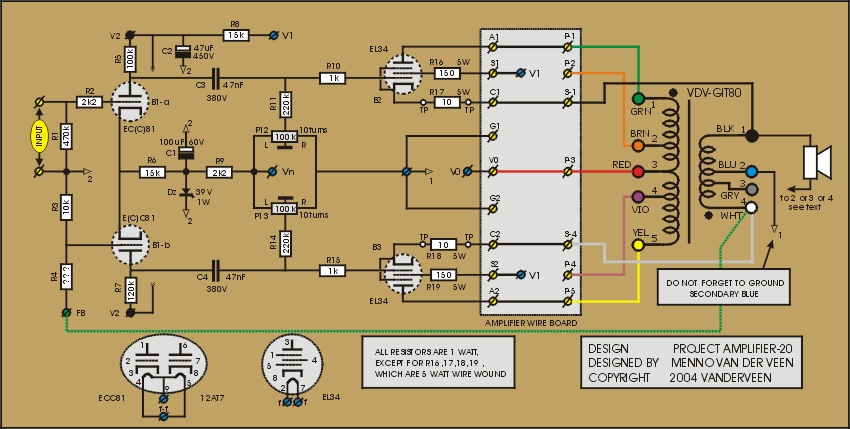Amplifier 20 does not differ so much from amplifier 19. The voltages at the screen grids and the center tap of the OPT are the same. The major difference is the local feedback at the cathodes of the power tubes. However, this small difference has major impact. See the schematics for more details and form-20 (click ![]() here) for the measurement results.
here) for the measurement results.
In amplifier 19 the power tubes were EL34 at a quiescent current of 25 mA. This small quiescent current causes severe third harmonic distortion at higher output levels, clearly visible in the Lissajoux measurement at the oscilloscope screen. The cathode feedback of amplifier 20 is able to make this distortion much smaller, but not small enough in my opinion. I therefore advise to use 6550 or KT156 power tubes at 40 or 50 mA quiescent current. Then you get the full impact of all the goodies of this very special amplifier.
Comparing amplifiers 19 and 20 shows that the open loop amplification Ao is almost 10 times smaller now, as is the output impedance. This is in very good agreement with feedback theory. The -3dB bandwidth has shifted to 38 kHz; the low output impedance of the tubes with cathode feedback is responsible for that.
This amplifier sounds very special. He is very loud and dynamic and clean; guitar players will love this sound. For high end reproduction you need to do some extra. Just apply a little extra overall negative feedback by means of R4. Start with 1 MOhm and listen, then a smaller value for R4 and listen again, un till the amplifier shows just enough extra damping to avoid mid-range coloration. With my loudspeakers (MC-3 of Rob Meyst) I needed this extra damping. However, this strongly depends on the type of speaker you use and on its impedance versus frequency behavior. In spite of this extra feedback, and in contrast to amplifier 19, the amplifier stays dynamic and very powerful. Don't use R4 for your guitar, there the local cathode feedback delivers enough damping. This amplifier is a beauty, a power beast and subtle at the same time. You almost can't imagine how much quality you get of such a simple design.
This was the last push pull amplifier of my project. Next time I will pay a lot of attention to Single Ended designs. I start with designs 1-3 and will show that SE is a totally different concept with challenges of a different dimension.
Next time: SE amplifiers 1-3

